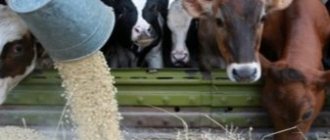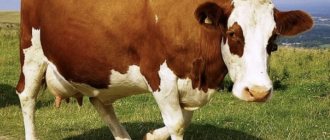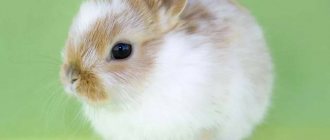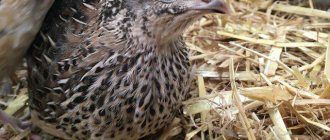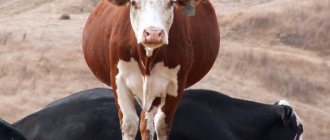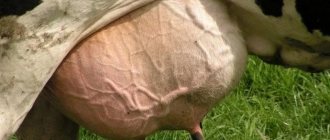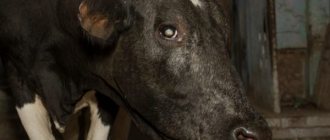Domesticated 1,000 years ago, today the cow has become a domestic animal unable to survive in the wild. The owners are interested in the question of how long a cow lives, which is not accidental, because the need to update the livestock to generate income depends on this.
The ability to determine the age of an animal is required when purchasing a new pet, so that an unscrupulous seller does not sell an old animal that is useless on the farm. It is better for a novice farmer to go after a cow with an experienced breeder or veterinarian who will not confuse the animal’s age by checking its teeth. The assistant will also assess the general condition of the cow, which will not be amiss.
What does life expectancy depend on?
Like any living creature, a cow is influenced by a number of factors that can lengthen or shorten its life: climate; country of residence, terrain (presence of nearby swamps, altitude); diet; conditions of detention; genetic characteristics of cattle, past diseases. An important factor is also the love of the owner or staff (if the animals are on the farm).
Affectionate treatment and a kind attitude mean a lack of stress and a positive atmosphere. Cows do not feel threatened, which means they sleep peacefully, eat better, give more milk, and their life expectancy increases.
How to increase the life of a cow
In order for a cow to live fully and productively, it is advisable to raise her in an ecologically clean area, give her healthy, nutritious, high-quality feed, prepared in advance; this will also affect milk production. Weather and climatic features also play an important role in how many years a cow is measured.
If breeders take good care of their cows and keep them in excellent conditions, they will remain healthy and productive longer. An insulated barn will definitely require timely repairs, caulking of cracks so that the animals do not get cold in winter, replacement of windows, and repair of the roof. The temperature in the barn in winter should be above ten degrees with a plus sign.
Advice: Cows should be surrounded with care and attention; they are living creatures; they feel a person, his mood and attitude towards them. It is useful to speak words of praise to the animal; the more caring and affectionate you behave with the cow, the more milk you can get.
If animals are treated roughly, they begin to become angry and kick in response, may not allow the owner to come in for milking, and sharply wave their tail. Different types of cows are characterized by individual physiological characteristics, which should be taken into account when choosing a breed for breeding.
Advice: Cows should undergo regular veterinary examinations.
Features of keeping in different conditions
It is also important where the cow lives - in a homestead or a large farm. If we talk about Russia, then in households cows have been actively used for household needs for about 15 years, and in large households - up to 12 years, respectively. In some regions, the life expectancy of an animal may be shorter due to factors such as:
- climate features;
- poor nutrition;
- short grazing period.
Also, many are actively interested in when to send an animal for slaughter when it stops producing milk. Naturally, it is not at all necessary to do this when the animal is about 15 years old and the cow no longer brings benefits to the owner, especially since during this time the owner manages to become attached to the animal.
Keeping a cow alive is your personal choice if you have the opportunity to contain, care for and feed it.
Lifespan of a cow
On average, a cow lives about 25 years; rare individuals live up to their fortieth birthday. The average life of a bull is much shorter, about 15 years. History also knows exceptions; the scientific literature describes the case of the longevity of the Irish cow Big Bertha; it exceeded fifty years. But at this age, the cow cannot be productive, milk is not milked, and the animal does not give birth.
If a cow is left at home or on a factory farm beyond her average lifespan, she will be of no use. Therefore, the animal should be released and slaughtered on time, and how many specific years it will live is decided by its owners based on many factors.
Tip: The decline in productivity of cows with proper feeding and care determines when they will be slaughtered for meat. In countries where cows are considered sacred creatures, they are left to live as long as they can until they die.
Tough
To find out the age of a female by her teeth, examine her jaw. It is necessary to investigate whether milk teeth have been replaced by molars. Her milk teeth are narrow and small, her molars are wide and large.
Therefore, it is quite possible to determine by eye. Important! After the age of 5, teeth begin to wear out. At ten years of age, a cow may lose its edges, especially if the food does not suit her.
Teeth are replaced by molars at the next age
- The first milk teeth that replace the permanent ones are the incisors.
- At 12–16 months, the animal changes these teeth. From 12 to 26 months, the middle inner teeth change.
- The middle outer molars appear at 2 years of age. The edges change at 2.5–3.5 years.
Economic age of cows
Cattle are valuable productive animals, the breeding of which in most countries is carried out exclusively for economic purposes. Therefore, real life expectancy is closely related to productive utility.
What influences the age of cows:
- fat content of milk;
- milk yield value;
- weight;
- meat quality.
Thus, beef cattle breeds rarely live more than 2 years, since after this age the average daily weight gain decreases sharply. The live weight of a five- and two-year-old bull does not differ much, and the funds for maintaining and feeding this animal over three years will cost much more than raising several more bulls. Therefore, meat breeds were selectively selected for early maturity, so that already at 15-18 months they could reach a weight of more than 500 kg and be successfully sent to the meat processing plant.
Beef cattle bulls usually live less than 2 years.
How long have cows been used?
In dairy farming the situation is different. The first difference is that age here is not calculated in years. Calving numbers are used to rate cattle over time. It differs somewhat from age in years - on average 2-3 years less. The first calving occurs at 2.5-3 years, after which the cow begins to produce milk; lactation continues throughout the rest of her life except for dry periods. Therefore, animals older than 15 years are found on dairy farms.
Farms rarely keep cows over 15 years old, since their maintenance is unprofitable.
Milk production is positively correlated with age up to a certain limit. So, at the first calving, milk yield is small, and with each subsequent calving they begin to increase, but at 5-6 they stabilize, and after the 8th they begin to fall. At the same time, relative fat content negatively correlates with the number of calvings - in the first, the mass fraction of fat has the highest indicator, and then gradually decreases.
What determines life expectancy?
Humans have the greatest influence on the use of cattle on a dairy farm. How quickly a cow will exhaust its reserve will depend on the method of housing, care, type of feeding and intensity of exploitation. But even without our participation, cattle will not last long - years of selection have made livestock highly dependent on people.
The first and most important role in the life expectancy of a cow is played by its breed. Thus, Holstein-Friesian cattle are designed for intensive production and milk production in any conditions. By worsening the diet, reducing the proportion of nutrients in it, we will not get serious fluctuations in milk yield - the cow will actively spend its reserves. At the same time, combined breeds and animals with low productivity can completely stop lactation with deterioration in feeding.
The next factor is content. Cows need to be provided with comfortable conditions with a temperature of 10 degrees, moderate humidity and no drafts. Wind and dampness have a much worse effect on their body than frost.
Feeding is no less important. Although most animals can survive on hay alone, they will not produce any milk yield. At the same time, you should not overfeed with concentrates - ketosis is one of the most common reasons for the retirement of cows at present.
Periods of life
The life of each cow can be divided into 3 periods. Knowing them, the farmer will be able to buy an animal at the most productive age.
- From 1 year to 18 months – maturation. The heifer is already large, and she is starting to feel the heat, but she is not yet ready for mating due to the insufficient development of her body;
- From 2 years to 15 years – maturity. The cow gives offspring and milk;
- 15 years or more - old age - lactation stops, fertilization does not occur, or ugly inferior offspring are born.
- A farmer needs to buy a heifer from 2 to 4 years old, then the profitability from the animal is maximum. If you buy a heifer that is older than 6 years, the lactation period will not be long, and if you plan to keep the animal for a long time, this option is not the best.
Stages of a cow's life and its duration
Before its birth, the animal enters the embryonic stage of development, and after that there is a postembryonic stage. The life of any creature begins with a zygote, after which the calf itself is born; at this stage three stages of development can be distinguished:
- The embryo, which lasts 34 days;
- The prefetal stage lasts 24 days;
- and everything ends with the fertile period.
Throughout this entire period of time, the cow must be well fed and well cared for, as well as provided with high-quality and long rest before calving.
The period of birth is a crucial moment in the life of an animal. Like a person, a calf experiences stress after birth, as its connection with its mother is interrupted, and now it enters into an independent life. In the first days after birth, he needs colostrum milk; during this period of life, this food is the only and very important one for him.
Then comes the milk period, most often it lasts from 3 to 5 months. This period of time, as well as all subsequent ones, cause great changes in the functions of the calf’s body, as well as in the structure of its body.
Breast milk smoothly flows into the period of puberty, at this time the baby begins to grow quickly and confidently, and get stronger: the mammary gland develops, and other processes in the “teenager’s” body begin to occur faster.
Puberty
Then maturity comes and during this period all the functions of the cow’s body flourish: the maximum amount of milk, the metabolism works perfectly, changes in the chemical composition of the body, and so on. It is at this time that the cow will be able to bear healthy offspring and produce the largest amount of milk.
Cow life at home
How many years a cow lives also depends on whether it is kept at home or in production. Unfortunately, today you don’t see these animals very often in an ordinary rural yard. More than 80% of all cattle in Russia are kept by professionals on large farms.
But for some, as in the old days, the cow remains the nurse. At the same time, when there are 1-2 animals on a farm, it is enough to simply provide them with an individual approach and good care. They value cattle more and are in no hurry to send them to slaughter.
All this affects how many years cows live at home. Their lifespan is noticeably longer than that of their relatives in production. On a private farm, a cow goes through several stages of development: maturation (1-1.5 years), the active period of calving and lactation (up to 14.5 years), aging (after 15 years).
Dairy cows, as a rule, live less than their counterparts by about 3-5 years, depending on their care and living conditions. It is important to understand that they do not produce milk throughout their lives. If they are in an important pre-death stage, then they only bring profits. Old cows eat a lot, sleep a lot and take up space. You can love an animal, but from a commercial point of view it looks wrong.
It is much better to turn an old cow into meat. This will be beneficial to both the animal and the owner, who will make a profit from the sale of beef, and the cow benefits from the fact that the person who wants to sell it for meat deprives it of its death throes. It turns out that the cow will not suffer. In general, this is a rational step that benefits both parties.
The life cycle of a cow, like any living organism, is divided into certain phases: childhood, maturity, old age. In this sense, the farmer, of course, is primarily interested in productive indicators - the period when the animal gives milk, as well as the reproductive age of bulls and heifers.
Phases of a cow's life
After birth, the calf remains with its mother or is fed milk or milk substitute for up to 6 months. From 1.5-2 months he is accustomed to solid food. Puberty occurs on average at 7 months. For the first time, young heifers are born at 1.5 years, breeding bulls - at 2 years. Gestation of a calf lasts 9-10 months, during which time the heifers’ bodies continue to grow. It is finally formed by the age of 4 years.
Cows happen to have a calf every year. Lactation duration is 10-11 months. If the cow does not become pregnant and remains single, it happens the following year. Proper milking can prolong lactation even in females who have become single. After 4 years, the animal is considered an adult and lives for as many years as its maintenance is economically profitable.
Conclusion
Each person, having a cow or bull on his farm, can extend its life and productivity. The same can be said about farmers - the life span of an animal depends on conditions , first of all. And this:
- A warm barn, the temperature in which in winter will not drop below 10 degrees;
- Healthy, nutritious food all year round;
- Veterinarian care, regular examination.
In order for there to be a normal amount of milk and it to be of high quality, the cow needs to be well fed with nutritious food. If the food is dry and non-nutritious, then you should not expect large milk yields.
How to determine the age of an animal
Every farmer should know how to determine the age of a cow. Determination is made by teeth. Like all animals, at first they are milk-bearing, and then are replaced by permanent ones. It is better to carry out the determination by the incisor hooks, on which the changes are most clearly visible.
They grow at 2 years old and wear off starting at 7 years old. When a cow reaches the age of 9 years, the surface of the incisors becomes quadrangular. Incisors become rare by the age of 12. After this, it is no longer possible to determine the age of the animal, and there is no need to do so.
By creating good conditions for his pet and observing disease prevention measures, the owner increases the life expectancy of the pet. The worse the owner treats his cow, the shorter its productive period will be. The peculiarity must be taken into account.
Using this online converter, you can easily calculate the number of years of the selected animal.
Factors influencing life expectancy
Many factors influence how long a cow will live. On large farms, heifers do not live long - from 7 to 10 years, until their milk yield begins to decline. In private households, animals are kept for up to 15 years. The main factors influencing the life expectancy of a cow are:
- In what natural zone does the pet live? If cows live in cold weather most of the year or, conversely, extreme heat, their body wears out faster. The immune system weakens and they begin to get sick more often. A short period of grazing also reduces the duration of the productive period, disrupting metabolic processes in the body;
- Housing conditions - when a cow lives in improper conditions, suffering from cramped conditions and dampness, she often dies from diseases while still young. If this does not happen, then the pet begins to lose productivity at the age of about 10 years, which greatly reduces the profitability of its maintenance;
- Individual characteristics - if an animal has developmental defects or has suffered from illness, you should not count on a maximum lifespan;
- Breed - animals that are distinguished by productivity wear out;
- The quality of raising a calf - if during the formation of the body the animal did not receive the necessary substances, it turns out to be weakened and incapable of living a full life;
- Quality of feed - if an animal does not receive enough vitamins and minerals, and the amount of food for it is small, then its health deteriorates.
